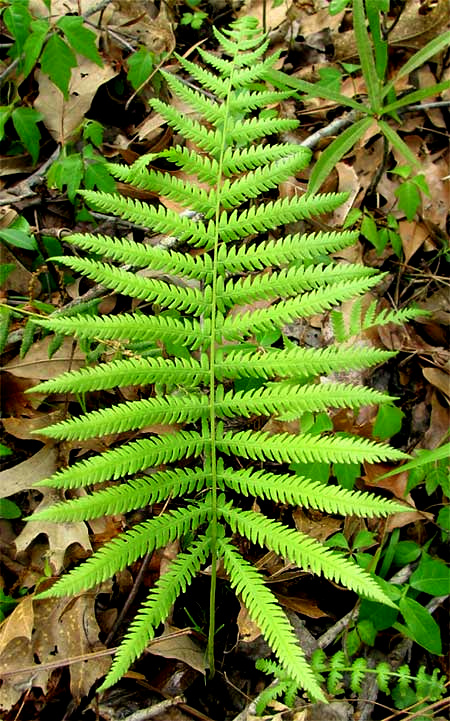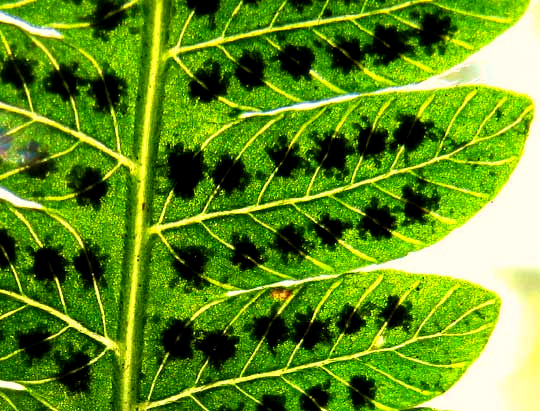Excerpts from Jim Conrad's
Naturalist Newsletter
from the April 6, 2009 Newsletter, issued from the forest near Natchez, Mississippi; elevation ~400ft (120m), ~N31.47°, ~W91.29°:
SOUTHERN SHIELD-FERNS
I've mentioned that by far our most common fern here is the Christmas Fern. In our upland, loess-soiled, oak/pine/hickory forests, maybe one in a thousand ferns is another species. Probably the most frequent "other species" is the Southern Shield-Fern, THELYPTERIS KUNTHII, shown below:

Despite this fern's elegant form and the neat way its lower pinnae diminish in size and point downward, distinguishing the species from similar ferns isn't particularly easy. To separate it from the Hairy Maiden Fern, Thelypteris hispidula, for example, I had to compare minor differences in venation of the pinna subdivisions, the pinnules.
These two very similar ferns are definitely distinct species, however, because Southern Shield-Ferns are tetraploids, with a chromosome number of 72, while the chromosome number of Hairy Maiden Ferns is only 36 -- they're diploids. Therefore, these two fern types can't interbreed, and that's a condition at the very heart of the definition of what a species is.
extra note dated October 18, 2009, issued from near Natchez, Mississippi:
SOUTHERN SHIELD-FERN VENATION & SORI
Now Thelypteris kunthii bears sori, which you can see below:

For identification purposes the venation is very important. In other Thelypteris species veins at the bottom of the sinuses between pinna lobes come together differently. In some species they join below the sinus and a connecting branch leads to the sinus, in others they mean the lobe margins well above the sinus bottoms. Fern specialists refer to these distinctive veins as "earmark veins."
from the October 13, 2002 Newsletter, issued from near Natchez, Mississippi:
SOUTHERN SHIELD-FERNS
Of all the weeks of the year, maybe this has been the one during which the Southern Shield-fern, THELYPTERIS KUNTHII, has been the prettiest. This fern dies back after frost so it's not present during the winter, and during spring it takes a while to unfurl all its new fiddleheads. Then through summer it generally grows retiringly in deep shadows. However, now, with clear October sunlight filtering down through the forest canopy, and that canopy admitting more and more sunlight every day because of caterpillars eating the leaves, and leaves falling during storms, or because fall is approaching and certain leaves are drying up and falling even though it rains a good deal -- now the forest on sunny days almost glows inside, and this special, transient light highlights especially the forest's Southern Shield-ferns.
Nowhere is the species more spectacular than on the broad, soaring, almost vertical walls of our deep bayous where Southern Shield-ferns display themselves in unbroken, cascading masses. Imagine a high wall totally mantled with large, tightly packed, frilly fern fronds arching outward and downward like green, gushing water. The sun shines on this as a light breeze blows, so that the fronds admit both the blackest shadows, the deepest greens, and scintillating patches of light so intense that they are more yellow or white than green, and the whole thing is sparkling-moist.
Southern Shield-ferns also appear here and there throughout the heavily shaded forest, often mingling with Christmas Ferns. It's a robust species with fronds 20 inches long (50 cm), a little hairy, and arising from wiry rhizomes a quarter of an inch thick (5 mm). This fern is so abundant at Laurel Hill that one would guess that it's common all through eastern North America. However, the species makes it no farther north than central Mississippi, though southward it extends all the way to Brazil.